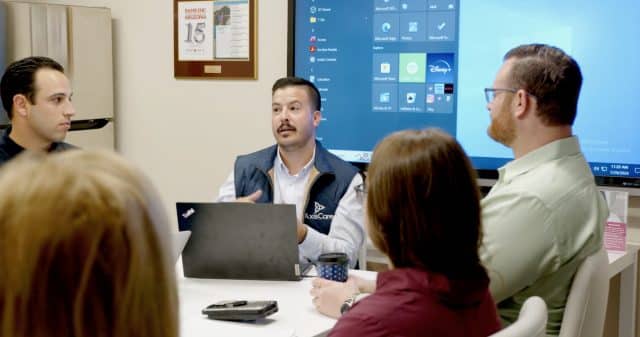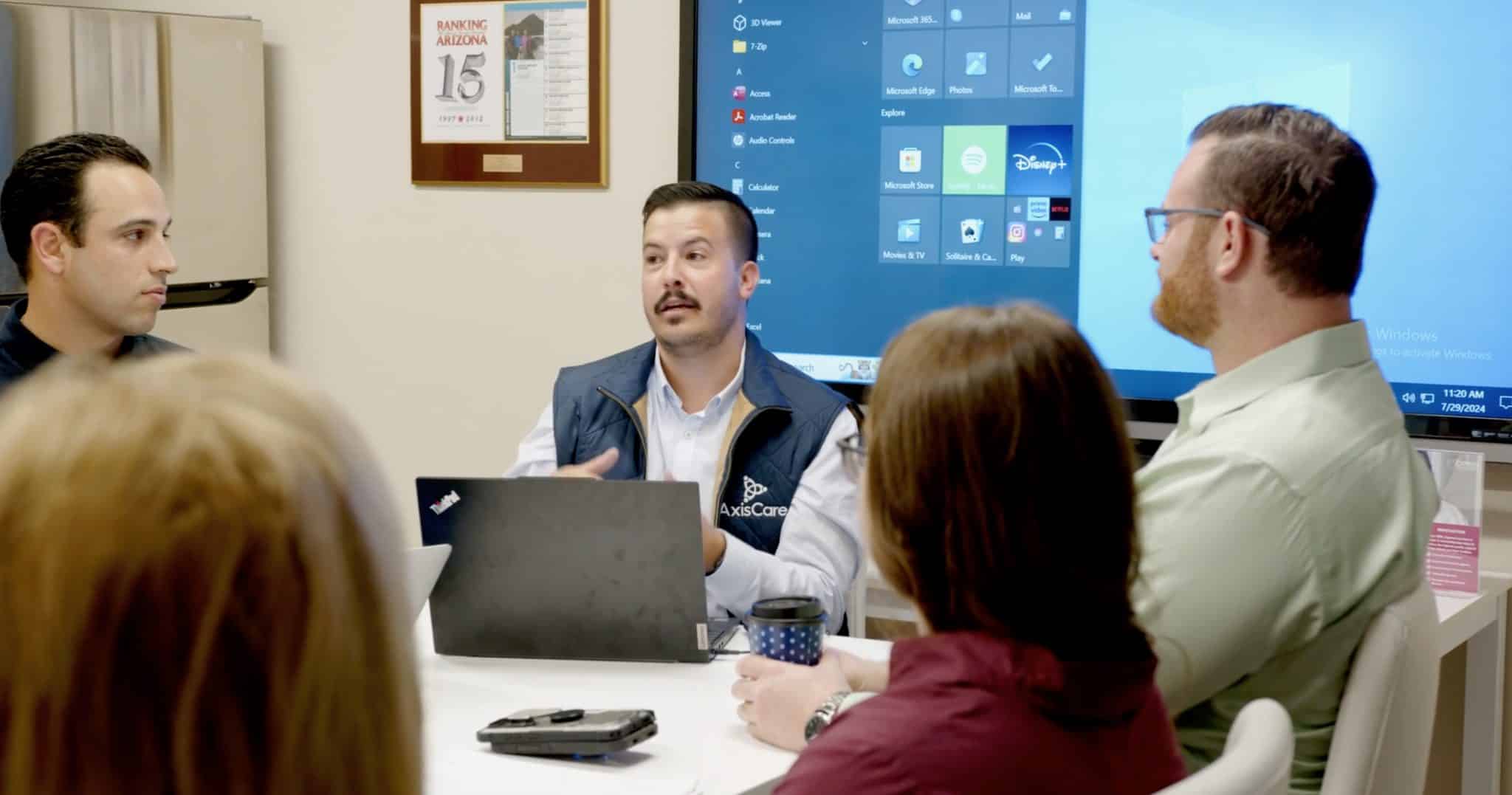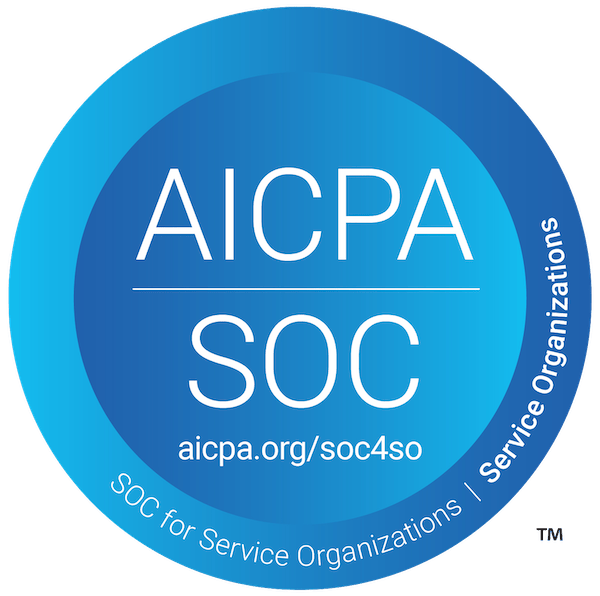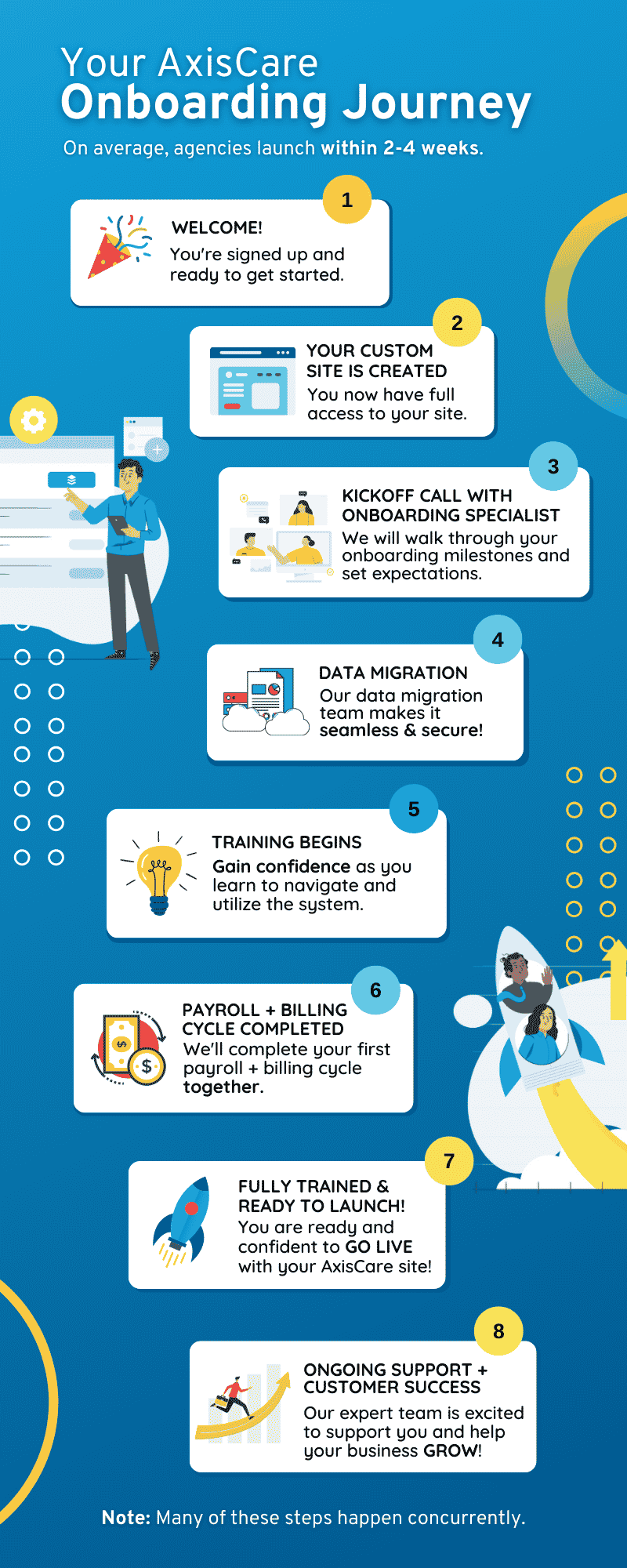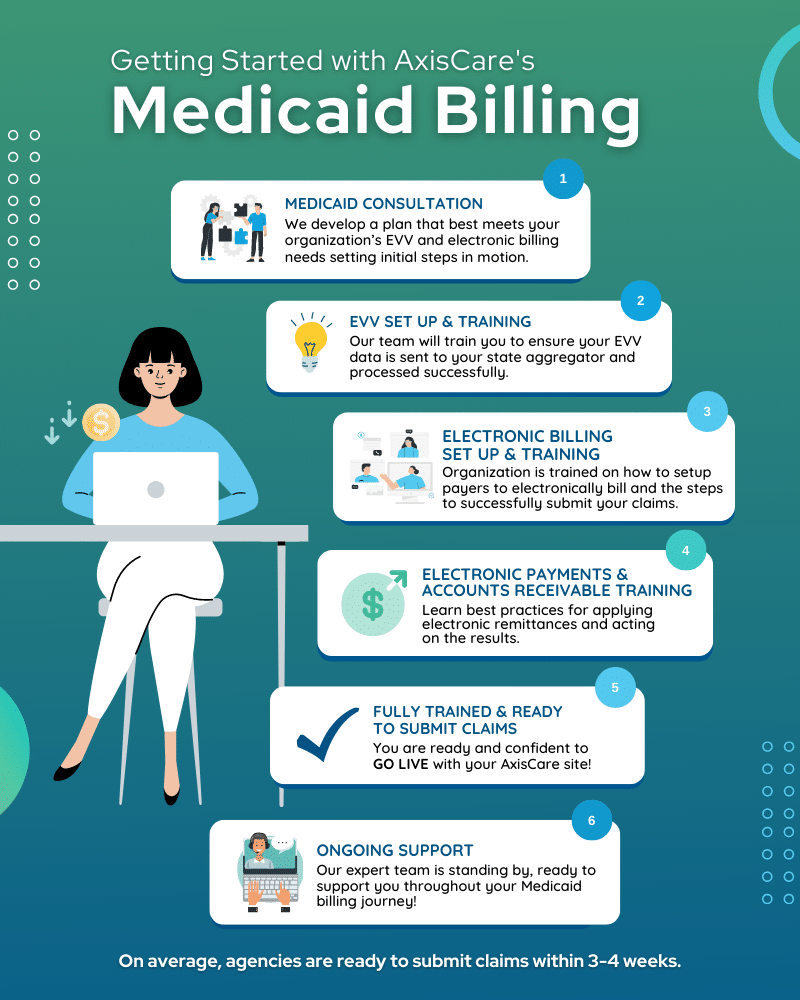The home health industry is a puzzle that’s only becoming more complicated with time. Market conditions continue to inflate the cost of doing business, while labor shortages are making it harder than ever to maintain a healthy roster of caregivers.
According to a third-party study commissioned by AxisCare, more than half of agencies across the US view caregiver recruitment and retention as the most existential issues for their business right now. Pile on financial pressures, regulatory complexities, and the challenge of integrating new technologies, and you have a true issue on your hands.
The first step is understanding the “why” behind each factor, then seeking to find a solution – so let’s take a look under the hood.
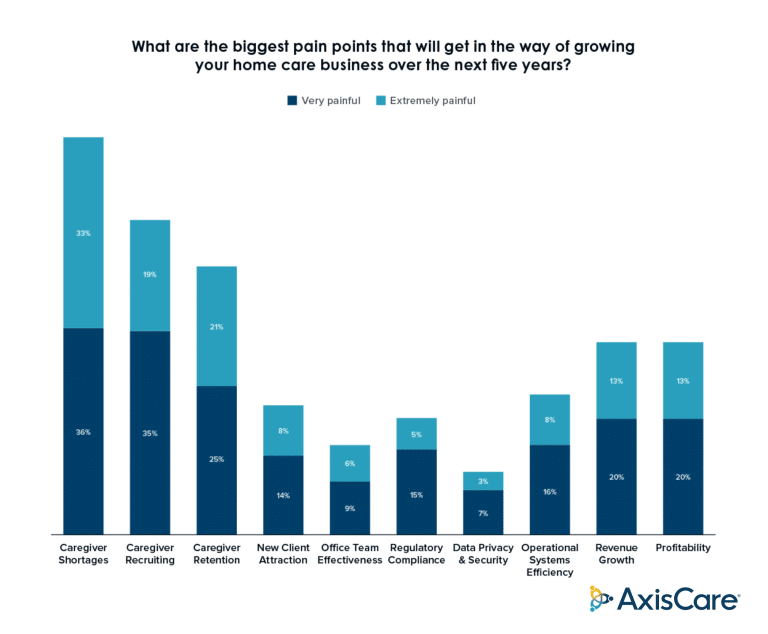
Staffing Shortages: The Looming Crisis in Care
The home health industry sits at the nexus of two major staffing challenges. First, the labor shortage that is sweeping the entire United States: recent data found there were only 6.5 million unemployed workers for 8.5 million job openings nationwide. And second, the fact that it’s notoriously difficult to both attract and retain employees for caregiving roles.
The Impact of Staff Shortages
Agencies of all sizes are feeling the short-staffing squeeze: in the aforementioned study, 69% of company leaders say their caregiver shortages are “Very Painful” or “Extremely Painful,” and 54% said recruitment is a persistent issue. The result is a multi-layered impact on the quality of service and client satisfaction.
A lack of caregivers means fewer hands on deck to serve patients’ needs, and a lack of flexibility to swap shifts or work around unexpected changes. Staff turnover also interferes with the consistency of care: while patients prefer seeing the same friendly face who is familiar with their situation and living space, more than half of caregivers fall off within just three months.
Recruitment Strategies That Work
Boosting caregiver retention starts at the very beginning of the hiring process. Something as simple as a well-written job description can already begin filtering for workers who are a better fit: be as specific as possible about the type of person you’re looking for and what they can expect from the role.
A paid trial period can also help weed out unfit candidates without having to commit to full training, and employee referral programs are a great way to connect directly with qualified candidates through a network you already trust.
Retention: More Than a Compensation Issue
It goes without saying that compensation needs to be competitive in a job market this tight. However, lifestyle benefits – especially given the physical and emotional toll of caregiving work – can also go a long way towards retention.
Paid time off is the bedrock of a healthy work-life balance, and flexible scheduling can actually work to an agency’s advantage as well when it comes to filling impromptu shifts. You can also get into more granular benefits like subsidized gym memberships, childcare benefits, and education opportunities can all contribute to a well-rounded life outside of work hours.
Financial Constraints: Balancing the Books Without Compromising Care
A slew of economic challenges are also putting a strain on home care agencies. 71% of surveyed agencies view the increasing costs of staff, supplies, and services as a noteworthy concern, which is causing many of them to increase the cost of their services.
However, another 69% of study participants view that increase as a hindrance to consumers—a necessary evil that, hopefully, won’t alienate too many potential patients. So, how can agencies manage their budgets without skimping on quality?
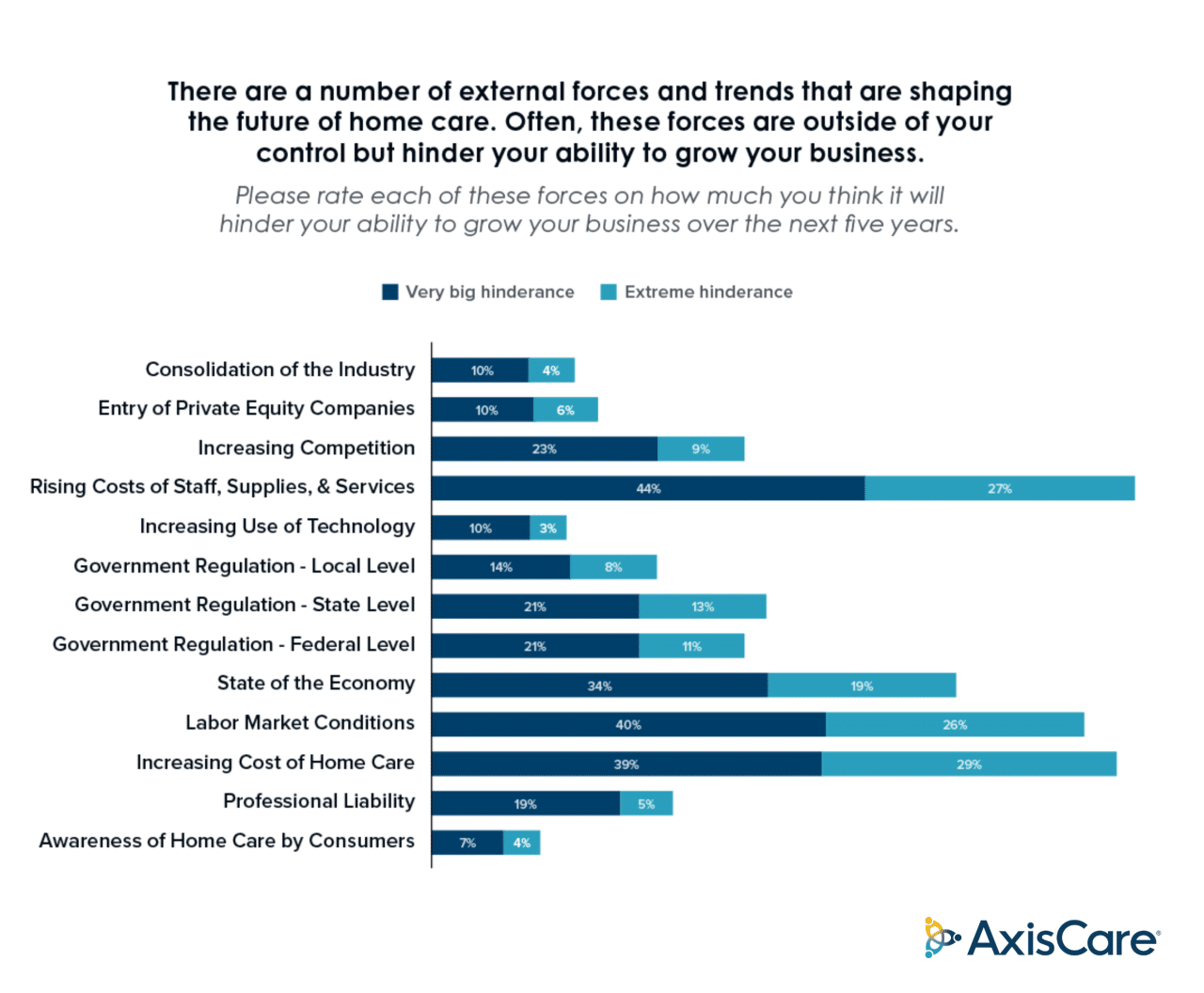
Understanding the Cost Structure
You may think you have a good understanding of your major cost centers, but you likely have plenty of frivolous expenses hiding in plain sight. Categorizing and closely scrutinizing your balance sheet is a good way to spot inefficiencies, redundancies, areas to eliminate unnecessary expenses, and even opportunities to renegotiate deals with suppliers.
Revenue Diversification & Optimization
Diversifying payer sources is another way for agencies to strengthen their financial position. Relying on a single type of client – whether it’s private pay or a subsidized program like Medicaid – leaves you vulnerable to sudden shifts like economic downturns or policy changes. Just like a stock portfolio, diversification dilutes your risk while opening the door to new earning opportunities.
Regulatory Compliance: Navigating a Complex Web
Compliance is the glue that holds the home care industry together. It puts forth strict standards for quality care, accountability, and adherence to regulatory standards, all of which are in a constant state of flux. The onus is on agencies to stay informed about regulatory updates and implement a compliance-first approach that keeps them on the right side of the law.
The Compliance Conundrum
Your agency might be compliant today, but since regulations are dynamic, they require constant vigilance. Both at the federal and state level, new legislation is constantly coming down the pipe – such as the new 80-20 provision, which obliges agencies to allocate at least 80% of Medicaid Home and Community-Based Services (HCBS) payments towards caregiver compensation.
Staying Ahead of the Regulatory Curve
You never want to be caught on your back foot when it comes to regulatory issues; a proactive approach to staying in the loop is key. Regular audits, strong relationships with regulatory bodies, and, most importantly, automating compliance will keep you ahead of the curve by keeping tabs on changing regulations, training staff on what’s new, and managing compliance documentation.
Technological Integration
The best way for agencies to level-up their operational efficiency is to adopt a home care software solution. These platforms are designed specifically for managing every angle of a home care organization’s tasks and responsibilities, from scheduling to compliance and billing.
Leveraging Technology for Success
Integrating home care software significantly improves operational efficiency, allowing for seamless coordination and reducing manual errors, not to mention the time savings. Home care software equipped with Business Intelligence (BI) tools gives access to real-time data insights, empowering owners with actionable information to make informed decisions and a true look into the health of their business. Moreover, advanced scheduling and management tools ensure that caregivers and clients are matched effortlessly, enhancing overall service quality and satisfaction.
The Human Side of Tech Adoption
These benefits are all well and good, but agencies will only be able to reap the rewards of their home care software if they train their staff properly. Properly educating your team will ensure they understand the full suite of features available to them, are well-equipped to make the most of the technology at their fingertips, and will feel comfortable enough to adopt this new tool for the long haul.
Strengthening your workforce is a goal that can be attacked from many angles. Delivering additional value through benefits and incentives for caregiver retention, leveraging AI for intelligent recruiting, and making caregivers’ jobs easier through technology are just a few of the many strategies agencies can adopt.
Case Studies & Expert Insights
Spotlight: Agency Unlocks Cost Savings and Operational Efficiency With AxisCare
Founded in 2018, Kids Individual Development Services (KIDS NW) rapidly emerged in the Medicaid care sector. This Oregon-based company, known for its unwavering commitment to quality care, was recently recognized in the Inc. 5000 as the 810th fastest-growing company in the United States. Upon switching to AxisCare, KIDS NW leveraged the flexibility of the platform to enhance its operational efficiency, and the results were immediate. With AxisCare’s versatile features and outstanding customer support, KIDS NW streamlined processes, improving company efficiency and saving nearly $300,000 in salaries to date. This allowed their team to redirect their focus towards critical business growth and scalability.
“AxisCare has probably been the biggest game-changer for our organization in the last four and a half years.”
– Kathy Lehmeyer, CEO & Founder, KIDS NW
Future-Proof Your Agency With AxisCare
The home health industry is up against an intricate web of challenges, all of which require strategic and proactive solutions. The path forward involves the ability to continuously adapt, whether it’s to changing market conditions or sudden regulatory updates. Agencies should be polishing their approach to recruitment and retention, examining their balance sheets for cost-cutting opportunities, and integrating technologies that take work off employees’ plates.
AxisCare can champion all of these changes and more. Book a live demo to see our home care software in action.



